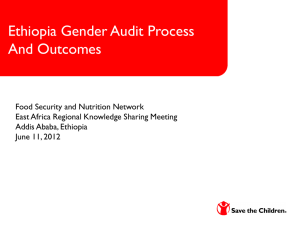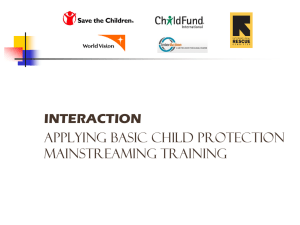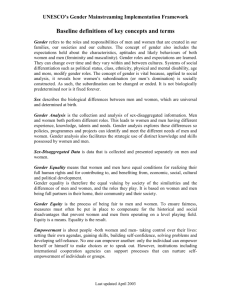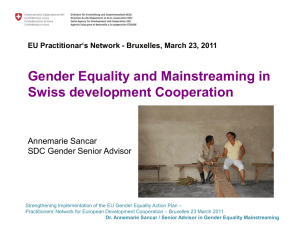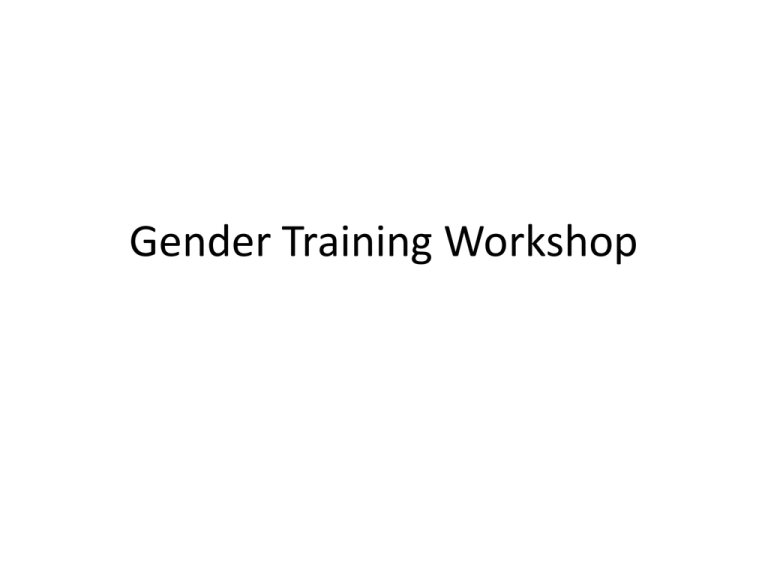
Gender Training Workshop
What is gender?
• Gender refers to the socially determined roles,
responsibilities, behaviour, characteristics of
women and men in a given culture
• Socialization at home, school, media, etc.
• Assimilated and learned, can change over time
and can vary within a given culture
What is gender?
SEX
GENDER
Biological
Socially-constructed
Born with
Not born with
Cannot be changed
Can be changed
Gender roles
• Division of labour is roles and tasks assigned to W/M
based on perceived characteristics and attributes,
instead of ability and skills
• W/G household and child-rearing responsibilities
• In general, these different roles usually result in W/G
having different and less access and control than M/G
to resources and decision-making processes
• Implications for life choices and opportunities
• Gender inequality in all areas of life
• Gender relations are the often unequal power relations
between W/G and M/B in a given society
W=women; M=men; G=girl; B=boy
What is gender equality?
• no discrimination in opportunities and in access,
control and use of resources, on the basis of a
person’s sex
• is not equal to women and girls
• about social relations between W/M
• means that W/G and M/B have equal conditions
for realizing their full potential and for
contributing to and benefitting from economic,
social, cultural and political development
Importance of gender equality
• Everyone has human rights
• Poverty is a gender issue, 70% of world’s poor are
women and girls
• If half the population has restricted or limited access to
relevant learning opportunities, a community’s social
and economic development will be limited
• Necessary for sustainable human development (gender
equality linked with poverty reduction)
• W/M are both drivers of social and economic
development
• Commitments involves obligations (i.e. CEDAW)
Importance of gender equality
According to statistics from the World Bank,
women usually reinvest 90% of their income in
their families and communities compared to
men who reinvest just about 30% to 40% of
their income.
Challenges in promoting gender
equality
• Changing socio-cultural values, beliefs and
attitudes takes time and often meets with
resistance
• Resistance because there is difficulty seeing
that a problem exists
• Change is required at the individual,
community, institutional and societal levels
• Existing power structures must change
Different approaches to pursuing
gender equality
• Women in Development (WID) developed in 70s
• Objective to design actions and policies to
integrate women into development
• Gender and Development (GAD) developed in
80s
• Objective to remove social, economic and
political inequalities between W/M
• Most agencies are adopting the gender and
development approach
How? Gender Mainstreaming
Gender mainstreaming is a process of ensuring
W/M have equal access and control over
resources, development benefits and decisionmaking
• Not about only women taking action
• Not about only women benefiting from it
How? Gender Mainstreaming
• “Mainstreaming a gender perspective is the process of
assessing the implications for women and men of any
planned action, including legislation, policies or
programmes, in all areas and at all levels. It is a strategy for
making women's as well as men's concerns and experiences
an integral dimension of the design, implementation,
monitoring and evaluation of policies and programmes in all
political, economic and societal spheres so that women and
men benefit equally and inequality is not perpetuated. The
ultimate goal is to achieve gender equality.” – UN
ECOSOC 1997
Gender mainstreaming
• Gender neutral means not recognizing that
gender is an influencing factor in social
outcomes
• Gender-responsive means being responsive to
the different needs of both M/B and W/G, as
well as actively trying to bring about more
equitable gender relations in a given context
How? Gender Mainstreaming
• asssessment and strategy
• Gender mainstreaming does not replace the need
for targeted, women-specific policies and
programmes or positive legation
• Gender Analysis is the assessment
• Gender Planning is the strategy
• Gender Planning refers to the process of planning
developmental programmes and projects that are
gender-responsive and which take into account
the impact of differing gender roles and gender
needs of W/M in a community/sector
Gender Analysis
• Tool for collecting and processing information
about gender
• Provides data disaggregated by sex
• Looks at gender roles
• To ensure W/M benefit from resources and
development (policies/programmes)
• Anticipate and avoid negative impacts
Gender Planning
• Gender Planning involves selecting
appropriate approaches to address not only
W/M practical needs, but also identifies entry
points for challenging unequal relations (i.e.
strategic needs) and to enhance genderresponsiveness of policy dialogue
Gender Needs
• W/M have different gender roles and gender needs
• Classified practical or strategic needs
• Practical Gender Needs (PGN): needs women identify
in their socially accepted roles
• PGN do not challenge gender divisions of labour or
women’s subordinate position in society
• PGN are a response to immediate and perceived
necessity, within a specific context
• PGN are practical in nature and often concern
inadequacies in living conditions, i.e. water provision,
education, health care and employment
Gender Needs
• Strategic Gender Needs (SGN): needs women
identify because of their subordinate position in
society
• SGN vary according to the context (gender
division of labour, power and control)
• Meeting SGN help women achieve greater
equality and change existing roles, thereby
challenging women’s subordinate position
• SGN are more long term and less visible than PGN
• SGN examples: legal rights, domestic violence,
equal wages, women’s control over their bodies

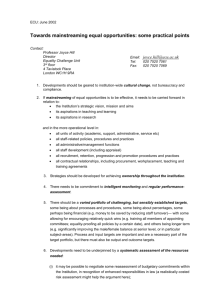
![Gender mainstreaming in higher education [PPTX 1.25MB]](http://s3.studylib.net/store/data/009261055_1-dfa19b70fcd91637c7a1dbd1bc939bd3-300x300.png)



